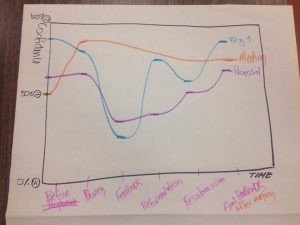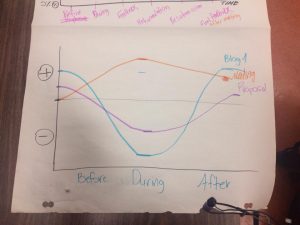HEY BLOG POST READER!
I know you’re eager to learn about a groovy project that jives with the Richmond Food Bank Society & The Vancouver Food Strategy, but wait… Before we get into the nitty gritty of our project objectives & related community organization, we will give you some back ground on this Land & Food Systems project process.
Background Information:
This University of British Columbia undergraduate course is centered around group work related to community based experiential learning. Through a voting process nine of us were put into the Vancouver Food Strategy project group. This project is unique because it is open ended, giving us the opportunity to develop a project revolved around the Vancouver Food Strategy. Our group coordinated to produce project ideas related to this strategy under additional constructs such as being related to SMART goals, Asset-based Community Development (ABCD), and food justice. The following week we gathered all project ideas, and through another voting process we divided the group of nine into two subordinate groups. One group decided to address grafting and the other group decided on coordinating a project revolving around the Richmond Food Bank Society. By clicking the Our Team tab you can learn more about us, the reasons why we chose this project, our interests, and what we wish to gain from this project.
Our Community Organization:
The Richmond Food Bank Society is located in the municipality of Richmond at the heart of metropolitan Vancouver. The Richmond Food Bank Society provides residents who are food insecure with food to help supplement their diet by connecting people, food, and services that are essential to health and well-being – the hallmark of a caring community. This society was founded in 1983 and it served about 20 families at the time. Today the food bank feeds about 1500 a week and is a registered charity (Richmond Food Bank Society, 2017). The food bank has recently changed the way they distribute food. Previously, they distributed food by providing clients with a basket of food that volunteers had picked out. To improve the food utilization the organisation switched over to more of a grocery store format. Clients now have more choice in determining which food products they would like to consume as they get to pick items from the different food stations resulting in better food utilization.
Project Objectives & Goals:
We would like to ride the wave of increasing food utilization of clients from the Richmond Food Bank. We will give the Richmond community a voice through interviewing them & enabling them to problem solve towards better food utilization through the means of the food bank. The food bank then better use their assets to fit the community vision. This type of aligns with ABCD because it gives the community of Richmond means to develop within their own assets. This improves community food system because it will improve the access to affordable food which addresses an aspect of Food Justice & the Vancouver Food Strategy. By addressing the SMART acronym we can further make the objectives clear by clarifying goals:
Specific because it is narrowed down to clientele food utilization in the Richmond Food Bank community.
Measurable in making target dates to complete specific tasks, target number of days the interviews will take place, & target number of interviewed people.
Attainable by narrowing down from the broad restraints of the Vancouver Food Strategy project to more specifically how food utilization in the Richmond Food Bank community attributes to this strategy. It is also attainable because we will use an interview method which has been used in the past successfully by the Richmond Food Bank Society. We also make weekly goals to further break down this process to ease attainability.
Relevant because this project is of main interest to our community organization & our own interests of gaining community based experiential learning of our local food system. This will keep our group motivated & engaged throughout the process.
Time-based because this project has due-dates through out this course between January & April 2017. Beyond this we make weekly goals within the team to make sure we abide by the due dates.
Our First Impressions of This Process:
After we had decided to work with the Richmond Food Bank for this project, it all seemed a little anti-climatic. We were all extremely excited by the idea but it was evident early on that we did not have much of a direction for the project. We automatically began talking about the many ways we could make the organization more equitable and the food that it provided to clients more culturally appropriate. These concerns are obviously valid, however we almost instinctively assumed a position of self-congratulatory moral authority and believed that we could, very much heroically “save” the Richmond Food Bank. Many of us in the group had an idea about the sort of work the Food Bank did but had no prior knowledge about the inner workings of the Richmond Food Bank and its clientele. Ironically, as we devised a plan of action and questions we hoped would introduce a more Food Justice orientated approach to the organization, we assumed that the clientele was a homogeneous body of people with certain experiences, struggles and needs. However, as we sat down to meet with our community partner it was evident that the Food Bank had addressed a lot of the concerns we had raised and by sitting down and listening to them we had realized that we had failed to account for complexity. We learnt that the clientele came from different ethnic and cultural backgrounds, spoke different languages, lived in different areas of the city and that meant every household had a unique relationship with the Food Bank and the services it provided. We also learned about & saw first hand how the Richmond Food Bank is a strong asset of the Richmond community. After having tentatively listening to our community partner we are now able to identify these differences and create a more appropriate and effective interview to meet the needs of the Richmond Food Bank Society and its clientele.
This was a good first hand experience that looking at a project from a needs point of view is less productive than an community asset point of view. We now know that rather than trying to solve a problem fresh out of the gates it is better to learn from a community first to help liberate their own assets. We hope by interviewing the clientele that we will further more learn about assets that the community can use through the food bank for better food utilization in the community. This will lead to better food justice because the asset of the food being offered can be morphed to better fit with the vision of the community. We now will be excited & open to learn from this community on their creative solutions to address community assets, Vancouver Food Strategy, & their interpretation of Food Justice.
References:
ABCD Animation. (2014, October 16). Retrieved February 06, 2017, from https://youtu.be/_muFMCLebZ4
Como conseguir doações para o seu projeto social. (2016, December 12). Retrieved February 06, 2017, from https://www.freetheessence.com.br/nova-economia/consumo-colaborativo/doacoes-projeto-social/
Kelly, Q. K. (n.d.). 4.3.5. Overview of Food Utilization and the Value Chain Approach. Retrieved February 06, 2017, from https://www.microlinks.org/good-practice-center/value-chain-wiki/food-utilization-and-value-chain-approach
Melissa Lafrance on January 12, 2016, Miranda Massie on October 29, 2014, & Colin Hearne on January 7, 2014. (n.d.). SMART goals. Retrieved February 06, 2017, from http://www.hr.ubc.ca/healthy-ubc-newsletter/tag/smart-goals/
Richmond Food Bank Society. (n.d.). Retrieved February 06, 2017, from http://richmondfoodbank.org/
Vancouver, C. O. (n.d.). Vancouver Food Strategy: Building just and sustainable food systems. Retrieved February 06, 2017, from http://vancouver.ca/people-programs/vancouvers-food-strategy.aspx
WHAT IS FOOD JUSTICE? (n.d.). Retrieved February 06, 2017, from http://justfood.org/advocacy/what-is-food-justice


